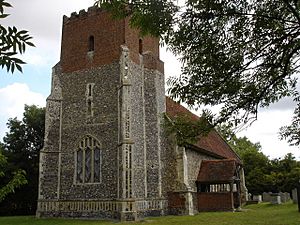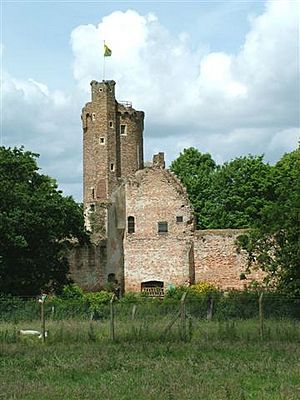Gilbert Debenham facts for kids
Quick facts for kids
Sir Gilbert Debenham Jnr.
|
|
|---|---|
| Born | 1432 Little Wenham, Suffolk, England
|
| Died | 1500 (aged 67-68) |
| Nationality | English |
| Occupation | Knight, Politician |
| Known for | Lord Chancellor of Ireland |
Sir Gilbert Debenham (1432–1500) was an English knight and politician. He also served as a soldier. For a short time, he held the important job of Lord Chancellor of Ireland. Like his father, he was known for not always following the rules. However, he did well during the time of King Edward IV. This was because he stayed loyal to Edward during a big political problem between 1469 and 1471. Later, under King Henry VII, he was accused of going against the King. He spent his last years in prison. His story is often mentioned in the famous Paston Letters.
Contents
Early Life and Reputation
Gilbert Debenham was born in Little Wenham, Suffolk. His father was Sir Gilbert Debenham senior (around 1404–1481). His father was a justice of the peace (a local judge) and a High Sheriff of Norfolk and Suffolk. He also served as a Member of Parliament. He worked for the Dukes of Norfolk. Our Gilbert was the fourth person in his family named Gilbert Debenham. His grandfather, also Gilbert Debenham, was also a Member of Parliament and died in 1417.
Some historians have said that both Gilbert Debenham and his father were known for being difficult. They were sometimes described as behaving in a rough way. However, the younger Gilbert's reputation might have been a bit better than his father's. His father was accused of using his power in the towns of Ipswich and Colchester for his own benefit. King Edward IV often allowed some people to act outside the law. This was if they supported him. Only when Gilbert went too far against the King did Henry VII take action against him.
A Knight's Career
Like his father, the younger Gilbert worked for John Mowbray, 4th Duke of Norfolk. In 1461, he also got a job from the King. He became the Clerk of the Market. This job involved checking weights and measures. He was a Member of Parliament for Ipswich from 1455 to 1456. He became a knight around 1461.
From 1465, the Debenhams had a big disagreement with the Paston family. They were fighting over who owned Caldecott Hall in Suffolk. In September 1465, Gilbert tried to take the hall but failed. Both Gilbert and John Paston junior started gathering groups of people to fight. But the Duke of Norfolk, who they both worked for, stepped in. He made them promise to keep the peace.
In 1469, the Duke of Norfolk himself turned against the Pastons. He claimed Caister Castle, which the Pastons had inherited. Norfolk took the castle after a long siege (a military blockade). Gilbert fought on Norfolk's side. He didn't seem to play a main role in the siege. His relationship with the Pastons got a bit better later. In 1477, John Paston married Gilbert's niece, Margery Brewes.
Serving the King
During a short time when King Henry VI was put back on the throne, Gilbert stayed loyal to King Edward IV. He went with Edward when he had to leave England. In March 1471, Edward tried to return to England. Gilbert was asked to check if it was safe to land in Norfolk. He correctly advised that it was not safe. After Edward's victory, Gilbert became one of the King's carvers. He also became a justice of the peace.
In 1473-1474, King Edward IV tried to strengthen his power in Ireland. This was partly because the Parliament of Ireland asked for help. Gilbert was made Lord Chancellor of Ireland. He was sent there with 400 men to bring order. Even though he was a strong leader, he found it hard to govern Ireland. Many English leaders found this task difficult. By 1476, he was back in England. He was in Marshalsea prison, likely because of money problems. He was soon released. He helped organize Edward's funeral. His career continued to do well under King Richard III.
Later Years and Challenges
After the House of York lost power in 1485, King Henry VII became the new king. At first, Henry VII was willing to use Gilbert's skills. In 1488, Gilbert was forgiven for supporting Richard III. In 1491, he was sent to Ireland again. He became the constable of Carrickfergus Castle. He also got the job of looking after the King's mines in Ireland.
In February 1495, Sir William Stanley was executed. Stanley had helped Henry VII win the Battle of Bosworth. He was accused of supporting Perkin Warbeck, who claimed to be the rightful king. Sir Robert Clifford said that Gilbert was also involved. Gilbert was found guilty of going against the King. He was not put to death, but he stayed in prison until 1499. His sister, Elizabeth Brewes, paid a large sum of money. In return, she got a pardon for her brother. She also got a promise that his conviction would be removed. Gilbert died in 1500. Later, Elizabeth's son Robert successfully had the conviction officially removed.
Family Life
Around 1469, Gilbert married Katherine Plumpton. She was the widow of William, 6th Baron Zouche. She died around 1472 and they had no children. His sister Elizabeth married Sir Thomas Brewes. He was the High Sheriff of Suffolk. Elizabeth and Thomas had a son named Robert, who became Gilbert's heir. They also had several daughters. The most famous is Margery. Her Valentines to her future husband John Paston are thought to be the first Valentine's Day letters written in English that we still have today.



